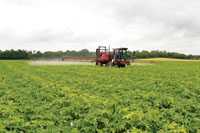‘GM technology will help potato growers meet demand’

GM technology must be considered to meet the new challenges for increased potato production, SCRI plant scientist Finlay Dale told the conference.
New varieties with improved resistance to pests and diseases and more efficient use of water and minerals were needed to meet consumer and environmental demands, he said.
Conventional breeding had an important role to play and would continue to do so. However, GM approaches allowed traits such as certain disease resistances to be identified and selected faster and more efficiently.
Informed debate with consumers was essential to balance concerns regarding “Frankenstein foods” with an appreciation of the potential benefits of GM technology, said Dr Dale.
“I think perceptions of GM have come a long way, but it’s a new science and we need to inform the public so they can see how and why we do this and make reasoned choices accordingly,” he said.
“The industry has to respond to consumer and EU led pressure to reduce chemical inputs so we have to consider all potential control options including GM approaches, particularly those that transfer potato genes from one variety to improve another.”
He thought GM technology would eventually become available in Europe, but in the meantime, marker technology was pushing the boundaries of conventional breeding, he said.
Marker-assisted selection allows breeders to pick out genes with beneficial traits, such as disease resistance, from the mass of genetic material within a plant and breed F1 generations faster and more accurately.
Conversely, conventional breeding crosses two parents to create an F1 generation. Thousands of plants are then planted in the field and each tested to see if it possesses the desired trait.
“Using molecular markers within conventional breeding programmes allows plants to be identified in the glasshouse, removing much of the time consuming field stage,” Dr Dale said.
Marker-assisted research at SCRI had already identified the gene which was capable of reducing populations of the potato cyst nematode Globodera pallida, he said. “We have identified stretches of DNA that are closely linked to the genes responsible for resistance to G pallida, allowing us to significantly improve the efficiency of our breeding programmes.”
To read about the EU giving the go ahead for a new GM potato variety to be cultivated in Europe click here.
Read more from the 2010 Crop Protection in Northern Britain Conference
• Industry must take harder line on disease control• Seed treatment promises scab control
• PCN sampler cuts waiting time
• Farmers voluntarily putting biodiversity measures in place

